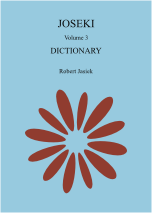
| Property | Joseki / Volume 3 : Dictionary | Traditional joseki dictionaries |
| Number of josekis | o | o ~ ++ |
| Number of failure variations | - | - ~ ++ |
| Stating equal / favourable results | ++ | ++ |
| Stating territory and influence values etc. | ++ | -- |
| General evaluation method | ++ | -- |
| Strategic choices and reasons | ++ | -- ~ o |
| Go theory is found easily vs. buried in the text | ++ | -- ~ - |
| Joseki classification | ++ | -- |
| Professional game examples | + | -- ~ + |
| Modern josekis included | + | -- ~ ++ |
| Relies on professional experience / databases | ++ | ++ |